
Risk Assessment & Compliance – Wrool IT Solutions
In today’s digital-first world, businesses face growing risks from cyber threats, data breaches, and regulatory requirements. At Wrool IT Solutions, we provide end-to-end Risk Assessment & Compliance Services to help organizations identify vulnerabilities, reduce risks, and ensure they meet industry standards. Our goal is to safeguard your business with proactive strategies that align with global compliance frameworks.
Why Threat Detection Matters
In today’s digital-first world, cybercriminals are constantly finding new ways to breach systems. From ransomware to phishing and insider threats, businesses face risks every day.
With 24/7 Threat Detection & Monitoring, Wrool IT Solutions ensures your network, applications, and cloud environment are continuously monitored to stop threats before they cause damage.
Why Risk Assessment is Important
Risk assessment is more than just identifying threats—it’s about preparing your business for the unexpected. By analyzing your IT infrastructure, processes, and data security practices, we ensure
- Early detection of vulnerabilities
- Reduced chances of cyber-attacks
- Stronger compliance posture
- Improved decision-making for risk management
- Long-term business resilience

Key Features of Our Risk Assessment Services
Our experts use advanced tools and methodologies to deliver
Risk Analysis
Identify potential threats and vulnerabilities across your IT systems and infrastructure.
Gap Assessment
Detect compliance gaps and align your business with regulatory requirements efficiently.
Threat Monitoring
Continuous observation of risks to minimize cyber-attacks and business disruptions.
Policy Review
Evaluate existing security policies to ensure strong protection and regulatory compliance.
Control Testing
Measure effectiveness of implemented security controls for improved resilience against threats.
Compliance Reporting
Deliver actionable insights with tailored reports for smarter risk management decisions.
Our Risk Assessment & Compliance Process
A structured step-by-step process to identify risks, analyze vulnerabilities, and ensure compliance with international standards for long-term business security.
1. Initial Consultation
We begin by understanding your business environment, IT infrastructure, and compliance needs.
2. Risk Identification
Detailed analysis of vulnerabilities, threats, and loopholes across all critical assets.
3. Compliance Analysis
Compare practices with global frameworks like ISO 27001, GDPR, HIPAA, and PCI-DSS.
4. Risk Prioritization
Risks are ranked by severity and potential business impact to address the most urgent first.
5. Action Plan
Develop and implement customized strategies that reduce risks and strengthen compliance posture.
6. Continuous Monitoring
Ongoing monitoring and periodic audits to ensure lasting security and compliance success.
Key Steps in Risk Assessment & Compliance Process
Initial Consultation – Understand business needs and compliance requirements.
Risk Identification – Spot vulnerabilities, threats, and weak points in systems.
Compliance Analysis – Compare with ISO, GDPR, HIPAA, PCI-DSS frameworks.
Risk Prioritization – Rank threats by severity and business impact.
Action Plan – Create strategies to mitigate risks and ensure compliance.
Continuous Monitoring – Regular audits and monitoring for lasting protection.
FAQ
Risk Assessment is the process of identifying, analyzing, and evaluating potential security threats and vulnerabilities in an organization’s IT infrastructure. It helps businesses understand their level of exposure and take preventive measures.
Compliance ensures that your business meets industry regulations and legal requirements such as ISO 27001, GDPR, HIPAA, and PCI-DSS. It prevents legal penalties, enhances trust, and protects sensitive data.
Ideally, businesses should conduct risk assessments at least once a year or whenever major changes occur in IT infrastructure, policies, or regulations. Regular assessments help in staying ahead of emerging threats.
Identifying potential risks
Assessing vulnerabilities
Analyzing compliance gaps
Prioritizing risks
Implementing security measures
Continuous monitoring & reporting
Industries dealing with sensitive data require it the most, such as banking, healthcare, e-commerce, IT, government, and manufacturing. However, all businesses benefit from risk management.
